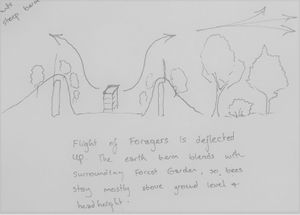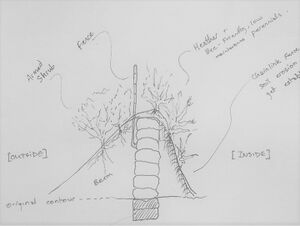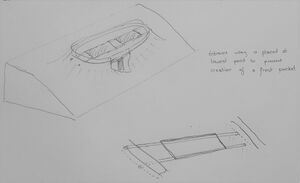This article is a discussion about how beekeeping could best be integrated with forest gardening, mainly focussing on how to house the bees.



Should bees be kept in a Forest Garden?
Bees are very important for pollination. It is not just honey bees that Many of the plants in a forest garden will not fruit without insect pollinators. By combining beekeeping with forest gardening, pollination is more reliable and yields can be maximized. This is particularly a consideration for the future as wild populations of bees continually reduce. With the rich diversity of species and the different flowering times that come with it, the forest garden habitat provides bees with a steady supply of nectar and pollen for most of the year. A forest garden might be so appealing to bees that foragers from surrounding wild bee colonies will frequently visit. It is even possible that wild bees will sooner or later establish themselves within a forest garden, as was the reported experience of Maddy and Tim Harland in their forest garden.
However, beekeeping has disadvatages, the need for intensive and regular management to prevent swarming foremost. It is ptentially not ideal if a bee swarm settles in an inconvinient place within the forest garden. Bees can also be aggressive, and since most forest gardens tend to be fairly small, potentially with objecting neighbours, this could be a problem. Following is a behaviour of some bees where they follow and attack any human or animal who comes near their colony, sometimes for some distance. Colonies differ in their aggression levels.
General considerations when designing apiary sites
According to Waring & Waring (2015),[1] the following are considerations in chosing where to site beehives:
- Shelter from strong winds. The hives should face away from prevailing winds so that returning foragers fly upwind, making manoeuvring easier. In sheltered site, hive entrance is best south facing. Thick hedges are ideal as a windbreak for an apiary site.
- Shaded in summer, but in sunlight during winter. Deciduous trees are suggested for this.
- Prevent animals from getting to the hives.
- Close to a water supply, but at least 6 m away from the hives.
- Consider keeping hives in a shed.
- Locate bees away from neighbours. Consider placing obstacles that cause bees to fly up and above head height to keep them out of people's way. Fine mesh or wire fences work as obstacles to bee flight paths, even if bees could easily fit through the apatures they prefer to fly over.
They advise that hives placed in the middle of a group of shrubs is ideal. Or at the edge of fields or woodland.
Suggested design to ideally site an apiary within a forest garden
The activity of insect pollinators is hampered by high winds.[2] European bees will not fly in windspeeds of 24 km/h, and flowers in sheletered location receive more bee visits than flowers in exposed sites.[2] Without successful pollination, some plants will not fruit or produce a poor yield (e.g. fruit trees). The bees will not tend to be active during windy weather (also if it is too cold or wet).[1] Workers will not forage as much, and consequently the efficiency of pollination will decrease.
References
- ↑ 1.0 1.1 Waring, A; Waring, C (2015). Get started in beekeeping. Hodder & Stoughton. ISBN 9781473611832.
- ↑ 2.0 2.1 Roubik, DW (1992). Ecology and Natural History of Tropical Bees. Cambridge University Press. ISBN 9780521429092.